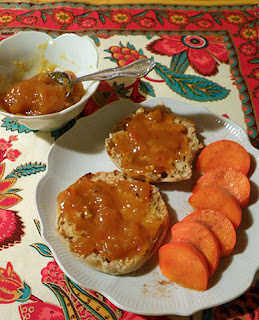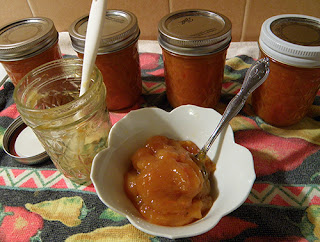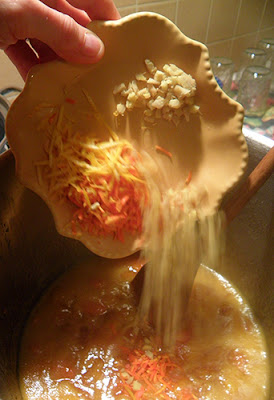 |
| Persimmon Marmalade with Fuyu Persimmons |
Recipe by Robin
‘Way back when during the winter of 02 – 03, when I
developed this recipe, I gave away over 400 oz. of this stuff. All told I
canned about 60 jars. I had only a vague recollection of my mother making jam,
and internet resources for recipes weren’t what they are today. Basically, I
had no idea what I was doing. Yet, with two giant Hachiya persimmon trees at my
(former) home, I couldn’t stand for the fruits to go to waste. True that crows
and starlings liked them, but their constant squabbling and wastefulness
annoyed me. Especially when they tossed the squishy remains all over the yard,
fence, and garden for you-know-who to clean up. After making 12 successful
batches (and one failure), I could barely think of making persimmon jam the
following year. Or any other year, until now.
 |
| Active (Flavor) Ingredients |
 |
| Rare Find: Winter Fruits to Preserve |
 |
| Zester Simplifies Preparation |
 |
| Add Peel & Ginger while Fruit is Foaming |
If you’re new to making jams and marmalades, see my Tools & Tips below. Warning: jam making can
become habit-forming.
makes ~28 oz.
6 cups ripe persimmon pulp
1½ packages low sugar pectin
4½ cups sugar
3 tangerines
2 lemons
2½ tbsp. peeled, chopped ginger
Sterilize clean jars by boiling in water for 20 minutes.
This recipe makes about five 12 oz. jars plus one 8 oz. jar; or eight 8 oz.
jars plus one 4 oz. jar (or 4 oz. for immediate consumption). Boil an extra jar
in case you need it. Remove jars with jar lifter and let drain inverted until dry. Put washed lids into a bowl and
cover with hot water from the pot.
Put 2 saucers into freezer. You’ll use these later to test
whether marmalade has gelled.
Prepare Hachiya persimmon pulp, being sure to use only
fruits that have no tannin taste. See detailed instructions here. You can also use soft (over-ripe) Fuyu
persimmons. Crush fruit with hand-held potato masher.
Use a zester
to grate the tangerine and lemon peel. You should have about 4 tablespoons. Cut
tangerines and lemons in half and use wooden reamer or similar devise to extract juice from each half. Strain out seeds.
You should have about ½ - 2/3 cup.
In a deep 8-quart pot, mix low-sugar pectin together
thoroughly with sugar, crushing all lumps. Add persimmon pulp and citrus juices
and stir to blend. Let it sit to allow fruit to macerate for 1 hour. Crush
fruit again with hand-held potato masher.
Heat mixture over medium high heat till boiling, stirring
constantly, about 10 minutes. Add citrus peels and ginger. Heat and stir as
mixture boils up and persimmons release air bubbles. Cook and stir until
mixture stops foaming, about 5 minutes.
When foaming subsides, turn heat to high. Stir constantly
until gel point is reached, about 8 minutes or less. Test marmalade
periodically: remove marmalade from heat, drop a spoonful of marmalade on a
chilled plate, return it to the freezer for a minute, and see if it stays in a
blob when plate is tilted. If it doesn’t stay together, or runs in rivulets,
keep boiling!
When test indicates that marmalade is gelled, remove pot
from heat and fill pre-sterilized jar using a ladle and jam funnel. Fill to ¼ inch from jar top. Wipe rim of jar with damp cloth. Pick
up sterilized lid with lid lifter, and shake off water. Cap jar with lid. Screw on ring gently, using
only one finger--don’t screw on tight! Air will release during hot water
processing.
Process jars in a hot water bath for 8 (8 oz jars) or 10
(12 oz jars) minutes. For best results, keep water temperature at 210 degrees. If marmalade temperature gets to 212 degrees, it can boil out of the jar and you'll have to reprocess. Use a digital meat or candy thermometer for best results. Remove from bath with jar lifters. Place hot jars on a
towel—not onto a cold tile surface! Tighten up rings when cool enough to
handle. A canning wrench makes tightening the rings a breeze.
Let sit overnight, or at least 12 hours. Check tops of jars
to ensure that lids have sealed; lids should not “snap” down when pressed with
thumb. If any jars have not sealed, either reprocess them or store in
refrigerator and eat within 2 weeks.
Super-ginger: Use 4
tablespoons (or more!) of ginger. Try adding ginger 5 minutes later.
Super-citrus: Use
juice and peel of 1 orange, 2 tangerines, and 3 lemons. You’ll use a total of ¾
cup juice and ~4½ tbsp. peel.
A few tools make working with boiling pots of water and jam less
intimidating. A jar lifter adds control when adding and removing jars from hot water baths. A magnetic lid lifter does the same for the lids. A wide-mouth jam
funnel makes it vastly easier to ladle the hot jam into the jars without
waste and burn hazard. I also wear oven
mits when stirring hot pots of jam, and while removing jars from hot water
baths. A canning
supply kit is an inexpensive way to get all the supplies you’ll need.
Otherwise, you just need two big pots. The largest pot
should be big enough to cover your jars with 2 inches of water and fit the
number of jars of jam that you’ll be making snugly (you can add empty jars as
spacers). This water bath is used both to pre-sterilize jars and to process
them after filling with jam. An official canning pot has an additional rack, which makes it easy to load and unload
jars for processing. This is very convenient, fairly inexpensive, and
simplifies the processing, but I made jam for years without one.
The smaller pot is where you’ll cook the jam. This must be
non-reactive; either stainless steel or enamel is best. I currently use a deep
8-quart stainless steel soup pot. Some jammers like a wider shallower pot,
which cooks the jam faster due to more surface area. However, a deeper pot
eliminates jam splattering out onto the stovetop—and the chef.
A digital thermometer with a spike, like a candy or meat thermometer, helps regulate the temperature while processing the jam. It will save you endless guessing and do-overs. 210 degrees F. is perfect for processing, 212 degrees is dangerous because if jam itself boils, the jar might not seal. Very much below 210 degrees isn't hot enough to ensure safety.
Happy Jamming! Feel free to comment with any questions.
A digital thermometer with a spike, like a candy or meat thermometer, helps regulate the temperature while processing the jam. It will save you endless guessing and do-overs. 210 degrees F. is perfect for processing, 212 degrees is dangerous because if jam itself boils, the jar might not seal. Very much below 210 degrees isn't hot enough to ensure safety.
Happy Jamming! Feel free to comment with any questions.
 |
| Digital Thermometer Helps Keep Temp Consistent |



I'm sure you're a pro at this--can these recipes be scaled down? I really don't need large quantities of marmalade (and I don't have any fruit trees) but just want to make some once in a while to use in recipes. I just tried making persimmon jam (or jelly) for the first time and learned the hard way about one persimmon ruining the batch.
ReplyDeleteHi Vanessa, yes most jam and jelly recipes can be scaled down or up. A smaller quantity will probably require less time to get to the gel stage, but if you happen to cook it a bit too long it will just get firmer. Since this marmalade is pretty soft to begin with, that shouldn't be an issue with this particular recipe.
DeleteIf you're using the canning/hot water bath processing, be sure to fill the jars to 1/4" from the top and process for the same amount of time you'd process a larger batch (8-10 min., details above). With a smaller quantity you might consider the refrigerator jam option (officially keeps for 2 weeks, but I've kept it longer if it will be re-boiled/used in cooking). You could also try freezing a smaller batch, after it has cooled down to refrigerator temp. Have fun with it!
Thank you Robin! I'm going to give this another try; if I wanted to use only persimmons and no other fruit, how much pulp do you think I'd need to make up for the loss of the citrus fruits?
ReplyDeleteVanessa, if you are canning with a hot water bath, you'll want to use enough acid ingredients to be sure that the jam is safe, ie. that bacteria can't grow. So do include 1/2 cup of lemon juice (or a bit more orange or a combination) in the full recipe, and scale it down when you cut down the recipe, but still include it. If you are freezing the jam and eating it within a few months, this acidity isn't as much of a concern. Be sure to eat any that is refrigerated (whether pre-frozen or not) within a week or two. As far as the fruit rind and ginger, I think you can make the recipe without them, without adjusting any other quantities. Have fun with it and let us know how it turns out. :)
DeleteHello again! My second attempt was much more successful although I may have overcooked it because it's now extremely thick. Still, it will probably be fine since I'm planning to use it to fill shortbread cookies. Thank you for the directions and advice. Happy holidays!
ReplyDelete